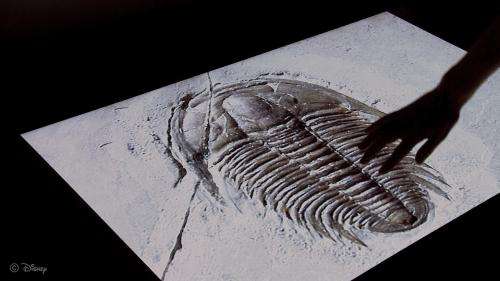Researchers develop algorithm for rendering 3-D tactile features on touch surfaces

A person sliding a finger across a topographic map displayed on a touch screen can feel the bumps and curves of hills and valleys, despite the screen's smooth surface, with the aid of a novel algorithm created by Disney Research, Pittsburgh for tactile rendering of 3D features and textures.
By altering the friction encountered as a person's fingertip glides across a surface, the Disney algorithm can create a perception of a 3D bump on a touch surface without having to physically move the surface. The method can be used to simulate the feel of a wide variety of objects and textures.
The algorithm is based on a discovery that when a person slides a finger over a real physical bump, the person perceives the bump largely because lateral friction forces stretch and compress skin on the sliding finger.
"Our brain perceives the 3D bump on a surface mostly from information that it receives via skin stretching," said Ivan Poupyrev, who directs Disney Research, Pittsburgh's Interaction Group. "Therefore, if we can artificially stretch skin on a finger as it slides on the touch screen, the brain will be fooled into thinking an actual physical bump is on a touch screen even though the touch surface is completely smooth."
Disney Research, Pittsburgh researchers will present their findings at the ACM Symposium on User Interface Software and Technology, Oct. 8-11, in St Andrews, Scotland.
In their experiments, the Disney researchers used electrovibration to modulate the friction between the sliding finger and the touch surface with electrostatic forces. Researchers created and validated a psychophysical model that closely simulates friction forces perceived by the human finger when it slides over a real bump.
The model was then incorporated into an algorithm that dynamically modulates the frictional forces on a sliding finger so that they match the tactile properties of the visual content displayed on the touch screen along the finger's path. A broad variety of visual artifacts thus can be dynamically enhanced with tactile feedback that adjusts as the visual display changes.
"The traditional approach to tactile feedback is to have a library of canned effects that are played back whenever a particular interaction occurs," said Ali Israr, a Disney Research, Pittsburgh research engineer who was the research lead on the project. "This makes it difficult to create a tactile feedback for dynamic visual content, where the sizes and orientation of features constantly change. With our algorithm we do not have one or two effects, but a set of controls that make it possible to tune tactile effects to a specific visual artifact on the fly."
"Touch interaction has become the standard for smartphones, tablets and even desktop computers, so designing algorithms that can convert the visual content into believable tactile sensations has immense potential for enriching the user experience," Poupyrev said. "We believe our algorithm will make it possible to render rich tactile information over visual content and that this will lead to new applications for tactile displays."
More information: www.disneyresearch.com/project/3d-touch-surfaces/
Provided by Disney Research


















